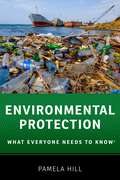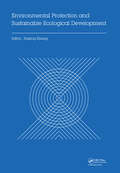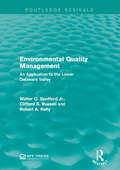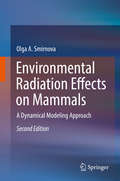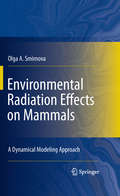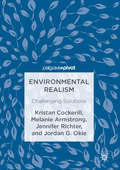- Table View
- List View
Environmental Processes and Management: Tools and Practices (Water Science and Technology Library #91)
by Raj Mohan Singh Prabhakar Shukla Prachi SinghThis book presents an in-depth, science-based approach to applying key project-management and spatial tools and practices in environmental projects. Providing important data for those considering projects that balance social-economic growth against minimizing its ill-effects on planet Earth, the book discusses various aspects of environmental engineering, as well as formula and analytical approaches required for more informed decision-making. Beginning with a broad overview of the factors and features of environmental processes and management, the book then clearly details the general application of fundamental processes, the characteristics of the different systems in which they occur, and the way in which these factors influence process dynamics, environmental systems, and their possible remedies. While primarily intended for professionals responsible for the management of environmental projects or interested in improving the overall efficiency of such projects, it is also useful for managers in the private, public, and not-for-profit sectors. Further, it is a valuable resource for students at both undergraduate and postgraduate levels, and an indispensable guide for anyone wanting to develop their skills in modern environmental management and related techniques.
Environmental Project Management: Principles, Methodology, and Processes (Environmental Science and Engineering)
by Ebenezer A. Sholarin Joseph L. AwangeThis book offers a new framework that facilitates the development of more intelligent systems and methods for data analysis and international information sharing, such as the use of satellite imaging and geospatial data to predict changes in weather conditions and shifts in water levels, and to assess the extent of the forest cover remaining on Earth that is visible from space. It brings together the many aspects of science and technology, as well as formula and analytical approaches required for more informed decision-making. It also highlights the vital importance of understanding the technological, economic and social dimensions of environmental projects that have short-term results and long-term impacts. It is unique in that it clearly distinguishes between environmental project management (EnvPM) and green project management (GreenPM), and presents an amalgamation of environmental management and project management concepts, using geospatial methods to form an EnvPM concept. The book sets a benchmark for the professionalism with which environmental projects should be planned, executed, monitored, assessed and delivered. While primarily intended for professionals responsible for the management of environmental projects or interested in improving the overall efficiency of such projects, it is also a useful handbook for managers in the private, public and non-for-profit sectors. It is a valuable resource for students at both undergraduate and master’s levels and an indispensable guide for anyone wanting to develop their skills in modern project management, environmental management and geospatial techniques.``We are the first generation to feel the impact of climate change, and the last generation that can do something about it.'' US President Obama's address to the United Nations on Climate Change and Global warming (2015)hison: This book provides an in-depth, well-researched and science-based approach to applying key project-management and spatial tools and practices in environmental projects. An important read for leaders considering projects that balance social-economic growth against minimising its ill-effects on Planet Earth. - Todd Hutchison, Global Chairman of Peopleistic group.
Environmental Protection: What Everyone Needs to Know® (What Everyone Needs To Know®)
by Pamela HillAlthough climate change and pollution make near-daily appearances in the news, humans have not always recognized that the environment needs to be protected. Only after the publication of Rachel Carson's Silent Spring in 1962 did environmental protection became a political and social priority. In Environmental Protection: What Everyone Needs to Know®, environmental lawyer Pamela Hill offers clear, engaging answers to some of the most pressing questions facing us today. She discusses the science behind current environmental issues, defining key terms such as ecosystems, pollutants, and endocrine disruptors. Hill explains why our environment needs protection, using examples from history and current events, from the Irish potato famine to the BP oil spill in the Gulf of Mexico and the drinking water crisis in Flint, Michigan. She also assesses the effectiveness of landmark laws and treaties, including the Clean Air Act, the Endangered Species Act, and the Kyoto Protocol. To what extent is it acceptable to rank human interests over ecological interests? And is it fair to ask developing countries to reduce emissions, even though they bear little responsibility for our current environmental problems? Hill identifies the greatest environmental threats we are facing today and suggests what we need to do as citizens, businesspeople, and lawmakers to protect the environment for each other and for future generations.
Environmental Protection Against Radioactive Pollution: Proceedings of the NATO Advanced Research Workshop on Environmental Protection Against Radioactive Pollution Almati, Kazakhstan 16–19 September 2002 (NATO Science Series: IV: #33)
by N. Birsen and K. K. KadyrzhanovNATO Advanced Research Workshop "Environmental Protection Against Radioactive Pollution" was held in Almaty on September 16-19, 2002. Experts from Azerbaijan, Denmark, Hungary, Kazakhstan, Kyrgyzstan, Norway, Russia, Tajikistan, Turkey, Ukraine, USA, Uzbekistan and the IAEA have participated and made presentations. The Workshop was organized parallel to the “2nd Eurasia Conference on Nuclear Science and its Application” held in Almaty on September 16-19, 2002 that was organized by Institute of Nuclear Physics of Kazakhstan with Turkish Atomic Energy Authority and National Academy of Science of Azerbaijan, National Academy of Science of Kyrgyzstan, Institute of Nuclear Physics of Uzbekistan. So, the number of participants for the Workshop was rather high. The NATO Advanced Research Workshop generated important interactions and provided a mechanism for scientists of different nations and of varied disciplines to discuss challenges that confront many countries around the world. The reports presented at the Workshop were published in this NATO Science Series. The main directions of the presented reports were as follows; General estimation of the radioactive contamination of the territories and radiation hazardous objects, including former military test sites, areas influenced due to Chernobly and Mayak accidents, and territories of oil fields; Techniques and procedures of radioecological monitoring; Techniques of determination of radionuclide concentrations and its species in the environment.
Environmental Protection and Disaster Risks: Selected Papers from the 1st International Conference on Environmental Protection and Disaster RISKs (EnviroRISKs) (Studies in Systems, Decision and Control #361)
by Nina Dobrinkova Georgi GadzhevThis book presents research findings and conclusions that has been developed as algorithms or intelligent new methods solving problems in the fields of air pollution, climate and health, natural hazards and risks, water resources, human activities and management and informatics, remote sensing, high-performance computing and GIS for environmental monitoring and management. Environmental protection and disaster risk topics are challenging fields, that scientific world is trying to address as much as it can. Earthquakes, floods, fires, droughts, blizzards, dust storms, natural releases of toxic gases and liquids, diseases and other environmental variations affect hundreds of millions of people each year. Many disaster events are triggered by human activities. Dealing with these problems will require systems thinking and integrating multidisciplinary science. Actions in these directions are taken more and more in the recent years by political bodies, NGOs and scientific groups trying to find sustainable solutions for the future generations. Every point of view matter when it comes to our global home – The Planet Earth.
Environmental Protection and Disaster Risks: Proceeding of the 2nd International Conference on Environmental Protection and Disaster Risks and 10th Annual CMDR COE Conference on Crisis Management and Disaster Response (Lecture Notes in Networks and Systems #638)
by Nina Dobrinkova Orlin NikolovThis book presents topics that are challenging fields that scientific world is trying to address as much as it can. Earthquakes, floods, fires, droughts, blizzards, dust storms, natural releases of toxic gases and liquids, diseases, and other environmental variations affect hundreds of millions of people each year. Many disaster events are triggered by human activities. Dealing with these problems will require systems thinking and integrating multidisciplinary science. Actions in these directions are taken more and more in the recent years by political bodies, NGOs, and scientific groups trying to find sustainable solutions for the future generations. Every point of view matters when it comes to our global home—The Planet Earth. The book presents research findings and conclusions that have been developed as algorithms or new methods solving problems in the fields of disaster management, natural hazards, risk reduction and building resilience, climate change challenges and security implications, air pollution and health, water resources and management and informatics, remote sensing, GIS, and high-performance computing. The 2nd International Conference on Environmental Protection and Disaster Risks in combination with the 10th Annual CMDR COE Conference on Crisis Management and Disaster Response brought together in the period June 06-09, 2022, in Sofia, Bulgaria scientists who presented their findings in the fast developing environmental management and disaster risk reduction field.
Environmental Protection and Sustainable Ecological Development: Proceedings of the 2014 International Conference on Environmental Protection and Sustainable Ecological Development (EPSED 2014), Wuhan, Hubei, China, October 24-26, 2014
by Jiaxing ZhangThis volume contains the papers presented at the 2014 International Conference on Environmental Protection and Sustainable Ecological Development (EPSED2014). The contributions cover the latest research results and explore new areas of research and development, like Earth Science, Resource Management, Environmental Protection, and Sustainable
Environmental Protection in Transition: Economic, Legal and Socio-Political Perspectives on Poland
by John Clark Daniel H. ColeThis book takes an interdisciplinary look at environmental protection during Poland’s transition to market democracy. The contributors are recognised experts in their fields, making this an authoritative volume, combining the perspectives of economists, legal scholars, political scientists and sociologists.
Environmental Protection in Transition: Economic, Legal and Socio-Political Perspectives on Poland
by John Clark Daniel H. ColeThis book takes an interdisciplinary look at environmental protection during Poland’s transition to market democracy. The contributors are recognised experts in their fields, making this an authoritative volume, combining the perspectives of economists, legal scholars, political scientists and sociologists.
Environmental Protection Strategies for Sustainable Development (Strategies for Sustainability)
by Abdul Malik and Elisabeth GrohmannThe environment of our planet is degrading at an alarming rate because of non-sustainable urbanization, industrialization and agriculture. Unsustainable trends in relation to climate change and energy use, threats to public health, poverty and social exclusion, demographic pressure and ageing, management of natural resources, biodiversity loss, land use and transport still persist and new challenges are arising. Since these negative trends bring about a sense of urgency, short term action is required, whilst maintaining a longer term perspective. The main challenge is to gradually change our current unsustainable consumption and production patterns and the nonintegrated approach to policy-making. This book covers the broad area including potential of rhizospheric microorganisms in the sustainable plant development in anthropogenic polluted soils, bioremediation of pesticides from soil and waste water, toxic metals from soil, biological treatment of pulp and paper industry wastewater, sustainable solutions for agro processing waste management, solid waste management on climate change and human health, environmental impact of dyes and its remediation. Various methods for genotoxicity testing of environmental pollutants are also discussed and chapters on molecular detection of resistance and transfer genes in the environmental samples, biofilm formation by the environmental bacteria, biochemical attributes to assess soil ecosystem sustainability, application of rhizobacteria in biotechnology, role of peroxidases as a tool for the decolorization and removal of dyes and potential of biopesticides in sustainable agriculture. It offers a unique treatment of the subject, linking various protection strategies for sustainable development, describing the inter-relationships between the laboratory and field eco-toxicologist, the biotechnology consultant, environmental engineers and different international environmental regulatory and protection agencies.
ENVIRONMENTAL PROTECTION WENK C: What Everyone Needs to Know® (What Everyone Needs To Know®)
by Pamela HillAlthough climate change and pollution make near-daily appearances in the news, humans have not always recognized that the environment needs to be protected. Only after the publication of Rachel Carson's Silent Spring in 1962 did environmental protection became a political and social priority. In Environmental Protection: What Everyone Needs to Know®, environmental lawyer Pamela Hill offers clear, engaging answers to some of the most pressing questions facing us today. She discusses the science behind current environmental issues, defining key terms such as ecosystems, pollutants, and endocrine disruptors. Hill explains why our environment needs protection, using examples from history and current events, from the Irish potato famine to the BP oil spill in the Gulf of Mexico and the drinking water crisis in Flint, Michigan. She also assesses the effectiveness of landmark laws and treaties, including the Clean Air Act, the Endangered Species Act, and the Kyoto Protocol. To what extent is it acceptable to rank human interests over ecological interests? And is it fair to ask developing countries to reduce emissions, even though they bear little responsibility for our current environmental problems? Hill identifies the greatest environmental threats we are facing today and suggests what we need to do as citizens, businesspeople, and lawmakers to protect the environment for each other and for future generations.
Environmental Quality Management: An Application to the Lower Delaware Valley (Routledge Revivals)
by Walter O. Spofford Jr. Clifford S. Russell Robert A. KellyEnvironmental Quality Management provides a quantitative analysis of regional residuals environmental quality management in the Lower Delaware Valley. Originally published in 1976, this study takes a management outlook to discuss new systems such as a non-linear aquatic eco-system model and reaches conclusions which have influenced research and management decisions about REQM across the world. This title will be of interest to students of Environmental Studies.
Environmental Quality Management: An Application to the Lower Delaware Valley (Routledge Revivals)
by Walter O. Spofford Jr. Clifford S. Russell Robert A. KellyEnvironmental Quality Management provides a quantitative analysis of regional residuals environmental quality management in the Lower Delaware Valley. Originally published in 1976, this study takes a management outlook to discuss new systems such as a non-linear aquatic eco-system model and reaches conclusions which have influenced research and management decisions about REQM across the world. This title will be of interest to students of Environmental Studies.
Environmental Radiation Effects on Mammals: A Dynamical Modeling Approach
by Olga A. SmirnovaDr. Smirnova's updated text is devoted to the theoretical studies of radiation effects on mammals. It summarizes 35 years of results the author obtained from analyzing dose rate equivalents for the Galactic Cosmic Rays (GCR) and for Solar Particles Events (SPE). This edition also includes two new chapters on skin epidermal epithelium and risk assessment for myeloid leukemia, as well as extended revisions addressing the radiation effects on the blood-forming system. Mathematical models are used to explain the effects of both acute and chronic irradiation on the dynamics of vital body systems, like the hematopoietic system, the development of autoimmune diseases, and the mortality dynamics in homogeneous and nonhomogeneous mammalian populations. The proposed methodology of these studies, the models themselves, and the obtained results are of a great theoretical significance and can find wide practical use.
Environmental Radiation Effects on Mammals: A Dynamical Modeling Approach
by Olga A. SmirnovaThemonographisdevotedtothetheoreticalstudiesofradiationeffectsonmammals. It summarizes the results obtained by the author over the past 30 years, most of them being of high priority. In the course of these studies, a single approach to the modeling of radiation effects on mammals has been elaborated. Speci?cally, in the framework of the developed deterministic mathematical models, the effects of both acute and chronic irradiation in a wide range of doses and dose rates on vital body systems (hematopoiesis, small intestine, and humoral immunity), as well as on the development of autoimmune diseases, are investigated. The radiation effects on the mortality dynamics in homogeneous and nonhomogeneous(in radiosensitivity) mammalian populations are also studied by making use of the developed stochastic models. The most appealing feature of these mortality models consists of the fact that they account for the intrinsic properties of the exposed organism. Namely, within these models the stochastic biometrical functions are calculated proceeding from statistical characteristics and dynamics of the respective critical body system (hematopoiesis or small intestine). The performed theoretical investigations contribute to the development of the system and quantitative approaches in radiation biology and ecology. These studies elucidate the major regulatory mechanisms of the damage and recovery processes running in the vital body systems of exposed mammals and reveal the key par- eters characterizing the processes.
Environmental Radioactivity and Emergency Preparedness (Series in Medical Physics and Biomedical Engineering)
by Mats Isaksson Christopher L. RaafRadioactive sources such as nuclear power installations can pose a great threat to both humans and our environment. How do we measure, model and regulate such threats? Environmental Radioactivity and Emergency Preparedness addresses these topical questions and aims to plug the gap in the lack of comprehensive literature in this field. The book explores how to deal with the threats posed by different radiological sources, including those that are lost or hidden, and the issues posed by the use of such sources. It presents measurement methods and approaches to model and quantify the extent of threat, and also presents strategies for emergency preparedness, such as strategies for first-responders and radiological triage in case an accident should happen. Containing the latest recommendations and procedures from bodies such as the IAEA, this book is an essential reference for both students and academicians studying radiation safety, as well as for radiation protection experts in public bodies or in the industry.
Environmental Radioactivity and Emergency Preparedness (Series in Medical Physics and Biomedical Engineering)
by Mats Isaksson Christopher L. RaafRadioactive sources such as nuclear power installations can pose a great threat to both humans and our environment. How do we measure, model and regulate such threats? Environmental Radioactivity and Emergency Preparedness addresses these topical questions and aims to plug the gap in the lack of comprehensive literature in this field. The book explores how to deal with the threats posed by different radiological sources, including those that are lost or hidden, and the issues posed by the use of such sources. It presents measurement methods and approaches to model and quantify the extent of threat, and also presents strategies for emergency preparedness, such as strategies for first-responders and radiological triage in case an accident should happen. Containing the latest recommendations and procedures from bodies such as the IAEA, this book is an essential reference for both students and academicians studying radiation safety, as well as for radiation protection experts in public bodies or in the industry.
Environmental Radon (Environmental Science Research #35)
by C. Richard Cothern James E. Smith Jr.This volume is intended for the professional who is a newcomer to the area of environmental radon. It marks the first time that chapters on these subjects have been brought together in a single volume, and it is arranged so that anyone with some basic university-level chemistry and physics can develop a clear understanding of the different aspects involved. The volume is intended to serve as a supplementary textbook in public health, environmental, and health physics courses. It also can be used by the professional to get "up to speed" in this rapidly evolving field. The chapters are not necessarily a discussion of the latest research in this fast-moving field, but are intended to bring the reader to a level at which he can easily understand the current literature. At the back of this volume the reader will find the references for the individual chapters, a general list of reading materials, a glossary, an appendix describing the equations for radioactive decay for a series of progeny, a table of often used conversion factors, and the addresses and brief biographies of the authors and editors. Both historical and SI (International System) units are used throughout the book to provide information for the widest range of readers. Thanks go to Tom Hess for the idea for this volume and to Jessica Barron for help in editing.
Environmental Realism: Challenging Solutions
by Kristan Cockerill Melanie Armstrong Jennifer Richter Jordan G. OkieThis interdisciplinary book challenges current approaches to “environmental problems” that perpetuate flawed but deeply embedded cultural beliefs about the role of science and technology in society. The authors elucidate and interrogate a cultural history of solutionism that typifies expectations that science can, should, and will reduce risk to people and property by containing and controlling biophysical phenomena. Using historical analysis, eco-evolutionary principles, and case studies on floods, radioactive waste, and epidemics, the authors show that perceived solutions to “environmental problems” generate new problems, leading to problem-solution cycles of increasing scope and complexity. The authors encourage readers to challenge the ideology of solutionism by considering the potential of language, social action and new paradigms of sustainability to shape management systems. This book will appeal to scholars in multi- and interdisciplinary fields such as Environment Studies, Environmental Science, Environmental Policy, and Science, Technology, and Society Studies.
Environmental Realism: Challenging Solutions
by Kristan Cockerill Melanie Armstrong Jennifer Richter Jordan G. OkieThis interdisciplinary book challenges current approaches to “environmental problems” that perpetuate flawed but deeply embedded cultural beliefs about the role of science and technology in society. The authors elucidate and interrogate a cultural history of solutionism that typifies expectations that science can, should, and will reduce risk to people and property by containing and controlling biophysical phenomena. Using historical analysis, eco-evolutionary principles, and case studies on floods, radioactive waste, and epidemics, the authors show that perceived solutions to “environmental problems” generate new problems, leading to problem-solution cycles of increasing scope and complexity. The authors encourage readers to challenge the ideology of solutionism by considering the potential of language, social action and new paradigms of sustainability to shape management systems. This book will appeal to scholars in multi- and interdisciplinary fields such as Environment Studies, Environmental Science, Environmental Policy, and Science, Technology, and Society Studies.
Environmental Reconstruction in Headwater Areas (NATO Science Partnership Subseries: 2 #68)
by JosefKřeček Martin J. HaighThese proceedings of a NATO Advanced Research Workshop on "Environmental Reconstruction in Headwater Areas" provide a landmark in the evolution of a distinctive movement, perhaps an emerging new philosophy, within the practice of headwater management. The Headwater Control movement traces its history back to the First International Conference on Headwater Control, Prague, 1989. Throughout this brief history, Headwater Control has remained a typical environment movement 'ad hocracy'. At its meetings, for every convert to the multidisciplinary, integrative, practical, interventionist, and above-all 'green' ideals of the group, there have been several delegates who have found the whole concept both new and slightly incomprehensible. One reason for this has been the Headwater Control practice of trying to bring together scientists, practitioners, policy-makers and non-government environmentalist organisations. The group's larger meetings have always been federal gatherings. Sponsorship has been shared with invited participation from associations representing hydrological science, soil conservation, erosion control, forestry, environmental activism and so forth. These delegations may have included fellow travellers in the work to protect headwater environments, but their main concerns have not necessarily coincided with the Headwater Control group's prescriptions for the environmental regeneration of headwater regions. The Liberec Workshop, whose proceedings are distilled into this volume, provided a first opportunity for the scattered supporters of Headwater Control to talk among themselves and fmd out to what degree there really is a shared vision of the way forward in headwater management, restoration and protection.
Environmental Regulations and Industrial Competitiveness: Case Studies of Toxic Industries in Southern California (Environment & Policy #62)
by Ward Thomas Paul OngWhile polluting industries in the U.S. continue to emit billions of pounds of toxic chemicals into the air, land and water every year, many economists and policy makers argue that environmental regulations stifle economic growth and reduce the standard of living for the American people. This book takes a fresh look at this question through three case studies of highly regulated polluting industries in the Southern California region: metal finishing, wood furniture, and dry cleaning. The case studies are based on a mix of qualitative and quantitative methods, including in-depth interviews with corporate managers and environmental regulators. The authors find that there is no universal pattern for predicting the effects of environmental regulations on industrial competitiveness, but that the outcomes depend on the structure of the industry being regulated, the design of the regulations, and the technologies that are available for compliance. The book is written in straight forward language that is accessible to the non-economist and will prove an essential resource for academics and students of all levels, and professionals and policy makers in the fields of environmental policy and regional economic development.
Environmental Release of and Exposure to Iron Oxide and Silver Nanoparticles: Prospective Estimations Based on Product Application Scenarios
by Henning WiggerIn this thesis a prospective approach was developed to identify and to assess current as well as potentially upcoming product applications with focus on environmental releases and exposures of engineered nanomaterials. The developed product application scenarios were illustrated in case studies on iron oxide and silver nanoparticles. It was shown that despite of prevailing knowledge gaps, reasonable estimations for environmental releases and exposures can be made. This novel approach facilitates the identification of early indicators for precautionary risk management measures and among them benign by design concepts in technology and product development.
Environmental Remediation Technologies for Metal-Contaminated Soils
by Hiroshi Hasegawa Ismail Md. Mofizur Rahman Mohammad Azizur RahmanThis book presents a comprehensive and detailed description of remediation techniques for metal-contaminated soils derived from both natural processes and anthropogenic activities. Using a methodical, step-by-step presentation, the book starts by overviewing the origin of toxicants and the correlated comparative extent of contamination to the environment. The legal provisions as proposed or applied in different countries are then discussed to explain the global regulatory situation regarding soil contamination and the extent of consequent concern. The core part of this publication describes the major techniques for in situ or ex situ treatment of the contaminated soil to meet the regulatory limits. Finally, risk evaluation is incorporated, giving special attention to possible impacts during or after implementation of the remediation strategies. The intrusion of metals in soils mostly occurs from various anthropogenic activities, e.g., agricultural practices, industrial activities, and municipal waste disposal. The volumes of metal-contaminated soil are becoming greater than before and are ever-increasing due to rapid urbanization, intensified industrialization, and/or population booms in certain parts of the world. Hence, the options previously proposed, such as isolation of the contaminated site or movement of the contaminated mass to a secure disposal site after excavation, are becoming unsuitable from the economic point of view, and instead, decontamination alternatives are preferred. This book will help readers such as scientists and regulators to understand the details of the remediation techniques available to deal with the soils contaminated by toxic metals.
Environmental Remediation Through Carbon Based Nano Composites (Green Energy and Technology)
by Mohammad Jawaid Akil Ahmad Norli Ismail Mohd RafatullahThis book examines carbon-based nanocomposite materials and their application in various environmental fields, such as wastewater treatment, and air and soil remediation. Featuring illustrations, and tables summarizing the latest research, it gathers up-to-date information on the application of carbon nanocomposites in the removal of environmental pollutants from different sources. Given its scope, the book is a valuable textbook for research students, and a useful handbook and reference resource for researchers, academics and industrial scientists working in the field of environmental pollutants and their safe removal.


